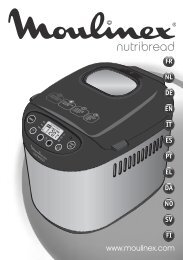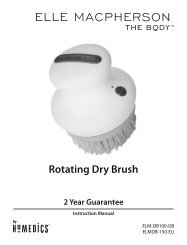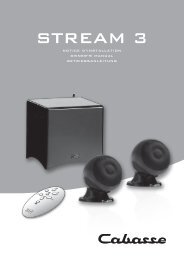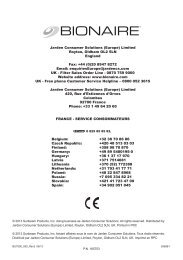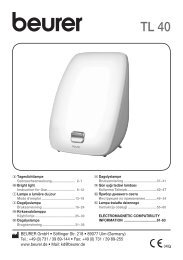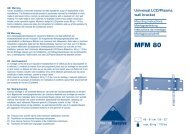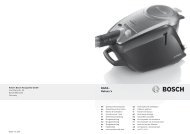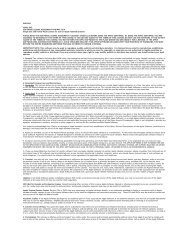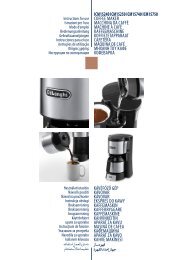19124 Iss 1 BM450 multilingual - Boulanger
19124 Iss 1 BM450 multilingual - Boulanger
19124 Iss 1 BM450 multilingual - Boulanger
Create successful ePaper yourself
Turn your PDF publications into a flip-book with our unique Google optimized e-Paper software.
fats and oils<br />
A small amount of fat or oil is often added to bread to<br />
give a softer crumb. It also helps to extend the freshness<br />
of the loaf. Use butter, margarine or even lard in small<br />
quantities up to 25 g (1 oz) or 22ml (11⁄2 tbsp.) vegetable<br />
oil. Where a recipe uses larger amounts so the flavour is<br />
more noticeable, butter will provide the best result.<br />
● Olive oil or sunflower oil can be used instead of butter,<br />
adjust the liquid content for amounts over 15ml (3 tsp)<br />
accordingly. Sunflower oil is a good alternative if you<br />
are concerned about the cholesterol level.<br />
● Do not use low fat spreads as they contain up to 40%<br />
water so do not have the same properties as butter.<br />
liquid<br />
Some form of liquid is essential; usually water or milk is<br />
used. Water produces a crisper crust than milk. Water is<br />
often combined with skimmed milk powder. This is<br />
essential if using the time delay as fresh milk will<br />
deteriorate. For most programs water straight from the<br />
tap is fine, however on the rapid one-hour cycle it needs<br />
to be lukewarm.<br />
● On very cold days measure the water and leave to<br />
stand at room temperature for 30 minutes before use. If<br />
using milk straight from the fridge do likewise.<br />
● Buttermilk, yoghurt, soured cream and soft cheeses<br />
such as ricotta, cottage and fromage frais can all be<br />
used as part of the liquid content to produce a more<br />
moist, tender crumb. Buttermilk adds a pleasant,<br />
slightly sour note, not unlike that found in country style<br />
breads and sour doughs.<br />
● Eggs may be added to enrich the dough, improve the<br />
colour of the bread and help to add structure and<br />
stability to the gluten during rising. If using eggs reduce<br />
the liquid content accordingly. Place the egg in a<br />
measuring cup and top up with liquid to the correct<br />
level for the recipe.<br />
yeast<br />
Yeast is available both fresh and dried. All the recipes in<br />
this book have been tested using easy blend, fast action<br />
dried yeast which does not require dissolving in water<br />
first. It is placed in a well in the flour where it is kept dry<br />
and separate from the liquid until mixing commences.<br />
● For best results use dried yeast. The use of fresh yeast<br />
is not recommended as tends to give more variable<br />
results than dried yeast. Do not use fresh yeast with<br />
the delay timer.<br />
13<br />
If you wish to use fresh yeast note the following:<br />
6g fresh yeast = 1tsp dried yeast<br />
Mix the fresh yeast with 1tsp sugar and 2tbsp of the<br />
water (warm). Leave for 5 minutes until frothy.<br />
Then add to the rest of the ingredients in the pan.<br />
To get the best results the yeast quantity may need to<br />
be adjusted.<br />
● Use the amounts stated in the recipes; too much could<br />
cause the bread to over-rise and spill over the top of<br />
the bread pan.<br />
● Once a sachet of yeast is opened, it should be used<br />
within 48 hours, unless stated otherwise by the<br />
manufacturer. Re-seal after use. Resealed opened<br />
sachets can be stored in the freezer until required.<br />
● Use dried yeast before its use by date, as the potency<br />
gradually deteriorates with time.<br />
● You may find dried yeast, which has been<br />
manufactured especially for use in bread machines.<br />
This will also produce good results, though you may<br />
need to adjust the quantities recommended.




